 After another very cold night at the Drakensberg, we have had enough of the cold weather. We prefer to wear our sunglasses instead of our woolen hat and decide to drive to the coast in one go, in search of better weather. A good decision, because once we are at the Indian Ocean, it is a lot more pleasant. Although the South Africans still find it bitterly cold and complain about the coldest winter in 20 years, is a perfect temperature for us Dutchies. It feels like a sunny spring day in Holland with a slight breeze. We turn off the heated grips and put away the rain suits that we had been wearing against the chilly wind.
After another very cold night at the Drakensberg, we have had enough of the cold weather. We prefer to wear our sunglasses instead of our woolen hat and decide to drive to the coast in one go, in search of better weather. A good decision, because once we are at the Indian Ocean, it is a lot more pleasant. Although the South Africans still find it bitterly cold and complain about the coldest winter in 20 years, is a perfect temperature for us Dutchies. It feels like a sunny spring day in Holland with a slight breeze. We turn off the heated grips and put away the rain suits that we had been wearing against the chilly wind.
Just like the temperature, the landscape has also changed. Everything is fresh and green and in full bloom, very different to the dry golden lands we passed earlier. After a long day we pitch our tent at a campsite in Umkomaas on a fresh green lawn under high palm trees. From the campsite we look out over the sea and hear the waves smashing on the beach. Although it is holiday-time in South Africa, it is quiet at the campsite. Apart from some regulars that keep an eye on us from behind the decorative curtains in their mobile homes, we are the only campers. We fall asleep that night to the sound of the sea without an extra blanket.
 The next day we drive a little further southwest to Port Shepstone. The road winds along the coast from Umkomaas. For the first time since Europe, we see other bikers on the road who, like us, appreciate the curves. As we are used to at home, we greet them by waving to them with our hand in the air. The greeting is answered with a short nod of the head, while they keep both hands firmly on the handlebars. In Holland we occasionally great with a single nod, but really only when we cannot let go of the handlebars. Peter and I turn it into a game to seduce the other riders to wave back at us but waving even more exuberant at them. But apparently the nod is way cooler here than the wave, because apart from two fingers that are lifted from the handlebars for a few seconds we only see them nod.
The next day we drive a little further southwest to Port Shepstone. The road winds along the coast from Umkomaas. For the first time since Europe, we see other bikers on the road who, like us, appreciate the curves. As we are used to at home, we greet them by waving to them with our hand in the air. The greeting is answered with a short nod of the head, while they keep both hands firmly on the handlebars. In Holland we occasionally great with a single nod, but really only when we cannot let go of the handlebars. Peter and I turn it into a game to seduce the other riders to wave back at us but waving even more exuberant at them. But apparently the nod is way cooler here than the wave, because apart from two fingers that are lifted from the handlebars for a few seconds we only see them nod.
All along the coast are large houses that have stunning views over the ocean. Often they are bungalows with one floor that are built in a large garden full of tropical trees and plants. It is definitely a wonderful place to live. The only thing that keeps us from moving here are the bars on the windows and the electric fences around the garden with the sign that refers to the “Armed Response”, the armed guards who will come to the house when the panic button is pressed. 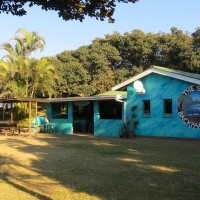 As in many other countries in Africa, it is most common to secure your home in this way against unwanted visitors. To us it still is a bit strange. We regularly ask ourselves whether it really is so dangerous everywhere or it has just become customary to use this level of security. We hope that we do not need to live behind a wall with an electric fence in the Netherlands any time soon.
As in many other countries in Africa, it is most common to secure your home in this way against unwanted visitors. To us it still is a bit strange. We regularly ask ourselves whether it really is so dangerous everywhere or it has just become customary to use this level of security. We hope that we do not need to live behind a wall with an electric fence in the Netherlands any time soon.
In Port Shepstone we find a nice camping spot at The Spot Backpackers, located at the sea. Once the tent is pitched, we walk onto the beach with binoculars to look for whales. In this period of the year Humpback whales migrate along the coast of South Africa. I have never seen a whale and had put ’seeing a whale’ on my bucket list for this trip. And we are lucky, because once we scour the horizon with the binoculars, we see whales that blow water high in the air through their blowhole each time they breath out. There must be lots of Humpback whales around, because we see fountains coming from the sea everywhere. And it gets even better because some of them jumping high out of the water to then fall -almost in slow-motion- back into the water with a loud thud. Awesome!
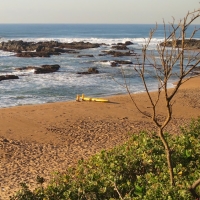 Humpback whales are not the only animals that hang around the coast of South Africa. This time of the year millions of sardines move along the coast to the east. It involves large schools of up to several kilometres long. The Sardine Run is compared to the migration of the wildebeests in East Africa. All those fish attract large numbers of predators, such as sharks, dolphins, seals, tuna, swordfish and sometimes even orcas. The school of sardines is driven to the surface by the cooperation of the predators after which they simultaneously attack. The fish are attacked from the air by large groups of Gape Gannets, cormorants and pelicans. A special natural phenomenon which attracts divers and film crews from all over the world.
Humpback whales are not the only animals that hang around the coast of South Africa. This time of the year millions of sardines move along the coast to the east. It involves large schools of up to several kilometres long. The Sardine Run is compared to the migration of the wildebeests in East Africa. All those fish attract large numbers of predators, such as sharks, dolphins, seals, tuna, swordfish and sometimes even orcas. The school of sardines is driven to the surface by the cooperation of the predators after which they simultaneously attack. The fish are attacked from the air by large groups of Gape Gannets, cormorants and pelicans. A special natural phenomenon which attracts divers and film crews from all over the world.
It is not entirely clear to scientists when the sardines migrate, making it extremely difficult to predict where they will be. Sometimes there are even not seen for a whole year. All along the South African east coast fans keep an eye on the water, reporting every activity by social media. In order not to miss the Run, dive centers all come out to Port St Johns from where they get out on the ocean every day. The dozens of boats with divers keep each other informed. Once the Cape Gannets start diving into the water, it is a sign that the sardines are driven into a large bait ball by the dolphins. That is the moment for the divers to enter the water and take a look under water with a mask and snorkel.
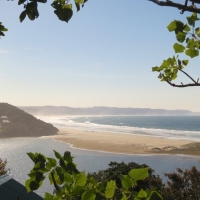 Although we had all seen images of the Sardine Run on television, we did not know that the fish were hanging around South Africa exactly around this time. That only became clear when we arrived in Port St Johns and spoke to the owner of Jungle Monkey Backpackers. Excited by his stories, we called a dive centre to ask if they might have two spots available on one of their boats. Now that we are here, we might as well attempt to see some action. And we are lucky, because they still have two spots available.
Although we had all seen images of the Sardine Run on television, we did not know that the fish were hanging around South Africa exactly around this time. That only became clear when we arrived in Port St Johns and spoke to the owner of Jungle Monkey Backpackers. Excited by his stories, we called a dive centre to ask if they might have two spots available on one of their boats. Now that we are here, we might as well attempt to see some action. And we are lucky, because they still have two spots available.
The lady on the other end of the line warns me that we will remain in the boat out on the open sea all day and will not return to shore, not even if one of us becomes seasick. Then she explains that, once we jump into the water, we will be in the water with a large number of sharks. She asks us whether we are comfortable with that. I have to swallow and get red cheeks of her question. I often get seasick and find it quite scary to just jump into the open sea, mainly because of sharks. However, I want to have a go at this adventure. If all those divers jump into the water with those sharks every day to watch the sardines, then it should be fine. Right? With a little tingle in my belly I reserve two places in the boat.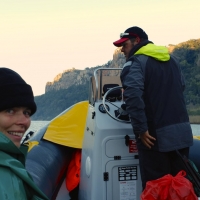
The next morning we report at the dive centre early and receive all the equipment we need. With five other divers and an instructor we get into a big rubber boat which has two very powerful engines. There is no harbour in Port St Johns, so the skipper of the boat must maneuver the boat from the river through the surf to reach the open sea. The ocean is particularly rough today, the waves are meters high. We get strict instructions from the skipper how to hold on. It is dangerous to fall into this rough surf, not only because of the high waves, but also because of the sharks. In clear water shark usually cause no trouble for divers, but in the murky water accidents happen frequently because the sharks do not see where they bite. Stay in the boat and do not fall out!
After several failed attempts to get through the surf, several boats give up and turn back. Our skipper continues to try and after 1.5 hours he manages to make it through the surf and out on the open ocean. We are all very happy to be on the other side of the surf. It was a particularly spectacular trip, one that is already worth the money we spent. Out on the open ocean we start looking for Cape Gannets. We pass along the coast and only once see a group of Gannets dive into the water. Unfortunately the bait ball swims in the murky water, where it is too dangerous for us.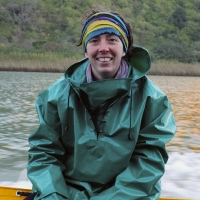 We patiently continue our search along the coast and await news from other boats. Also on the open sea the waves are very high and after the adrenaline of the ride through the surf is gone, I am seasick most of the day. Especially when we float, I had to bend over the side of the boat several times. I am secretly quite relieved when the skipper announces that we will be returning to the shore at the end of the afternoon. Not it the last place, because I already had all sorts of visions of hungry sharks that came in my direction, rather than towards the sardines. It was just enough adventure for one day.
We patiently continue our search along the coast and await news from other boats. Also on the open sea the waves are very high and after the adrenaline of the ride through the surf is gone, I am seasick most of the day. Especially when we float, I had to bend over the side of the boat several times. I am secretly quite relieved when the skipper announces that we will be returning to the shore at the end of the afternoon. Not it the last place, because I already had all sorts of visions of hungry sharks that came in my direction, rather than towards the sardines. It was just enough adventure for one day.
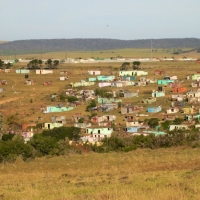 The next day we get back on the bikes for some nice quiet days on the bikes. The first day we drive along the coast to Chintsa, but after that we leave the ocean and ride from the coast into South Africa again. If you would only stay on the coast of South Africa you might get the idea that you are in an extremely prosperous country. But appearances can be deceiving, because as soon as we have left the coast with its luxury homes and big cars, we enter the ‘other’ South Africa where a large part of the population still lives under primitive conditions in huge townships. The townships arose during the apartheid when the non-white population was driven out of the towns into specially designated areas. Although apartheid was abolished more than twenty years ago, a significant proportion of the population still lives in the townships. You will find the townships with the small colored houses not only around major cities like Johannesburg and Pretoria, but actually on the outskirts of every village and every town. They are working hard to improve the living conditions in the townships. The corrugated iron shacks are replaced throughout the country by stone houses that have electricity and hot water. Still, it will take some time before all the millions of inhabitants of the townships will benefit of these improvements and South Africa will actually go through as a prosperous country.
The next day we get back on the bikes for some nice quiet days on the bikes. The first day we drive along the coast to Chintsa, but after that we leave the ocean and ride from the coast into South Africa again. If you would only stay on the coast of South Africa you might get the idea that you are in an extremely prosperous country. But appearances can be deceiving, because as soon as we have left the coast with its luxury homes and big cars, we enter the ‘other’ South Africa where a large part of the population still lives under primitive conditions in huge townships. The townships arose during the apartheid when the non-white population was driven out of the towns into specially designated areas. Although apartheid was abolished more than twenty years ago, a significant proportion of the population still lives in the townships. You will find the townships with the small colored houses not only around major cities like Johannesburg and Pretoria, but actually on the outskirts of every village and every town. They are working hard to improve the living conditions in the townships. The corrugated iron shacks are replaced throughout the country by stone houses that have electricity and hot water. Still, it will take some time before all the millions of inhabitants of the townships will benefit of these improvements and South Africa will actually go through as a prosperous country.
 We drive past large farms and private game parks where zebras, antelopes and sometimes even big cats such as lions a kept. We stay on a lovely campsite in Addo for two days and then continue to the entrance of the Baviaanskloof Nature Reserve. There is a dirt road that runs through the park and the gorge of the river ’Grootrivier’, which was recommended to us by several other motorcycle travelers.
We drive past large farms and private game parks where zebras, antelopes and sometimes even big cats such as lions a kept. We stay on a lovely campsite in Addo for two days and then continue to the entrance of the Baviaanskloof Nature Reserve. There is a dirt road that runs through the park and the gorge of the river ’Grootrivier’, which was recommended to us by several other motorcycle travelers.
After buying some groceries in Addo and filling our tank, we arrive at the entrance of the park at the end of the morning. There is a sign that says it is about a 41km’s drive to Camping Rooihoek. A distance we normally cover in less than half an hour on a paved road. On the sign is indicated that it will take us at least 3 hours to get there. Apparently at an average speed of 14 kilometres per hour. That is not fast and will be related to the poor conditions of the road. But we still have the whole afternoon to get there, so that should be no problem.
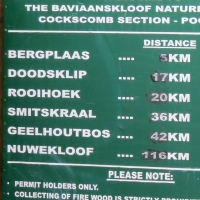 We drive into the park and follow a nice gravel road into the hills. We have driven quit far since we left Addo and have to start thinking about getting some fuel. We always carry extra fuel with us, but it so happens that we have just emptied our big 6.5-liter jerry cans yesterday. We thought we would drive through several villages in the Baviaanskloof, but the only houses we see on this side of the park are abandoned. We still decide to keep on going and try to get fuel at the campsites down in the gorge.
We drive into the park and follow a nice gravel road into the hills. We have driven quit far since we left Addo and have to start thinking about getting some fuel. We always carry extra fuel with us, but it so happens that we have just emptied our big 6.5-liter jerry cans yesterday. We thought we would drive through several villages in the Baviaanskloof, but the only houses we see on this side of the park are abandoned. We still decide to keep on going and try to get fuel at the campsites down in the gorge.
A little further on we have to stop in front of a closed gate. A man comes from post and asks us for our permit. “Permit? We surely do not need a permit for a public road?“, we ask him. However, while it is indeed a public road we have to buy a license to drive through the park. Fortunately, we can get that from him. While issuing the tickets for us, I ask him where we can buy fuel. He makes a worried face and explains that if we need fuel we will have to drive back to the village we passed that morning. That is too far back. We are not entirely reassured, especially now that the big jerrycans are empty, but decide to continue driving. As we drive slowly we do not use a lot of fuel anyway. And from here it is only 20km to the campsite, who knows what we can buy there.
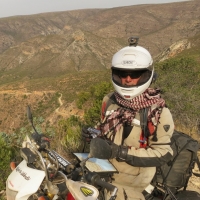 We pass the now open gate and enter the middle part of the park. The gravel road in this part is clearly not as good as in the first part. It has deep gullies that have been carved by water, no wonder ordinary passenger cars are not allowed in this part. Especially on the parts with loose stones we have to keep paying attention to the road. We drive on the narrow road along a steep cliff up into the hills. From there we have a beautiful view over the park and gorge that passes through it. The wind is blowing hard and we need to hold on to our handlebars tight to stay on the road. If we would encounter another biker now, we would have to greet him with a nod.
We pass the now open gate and enter the middle part of the park. The gravel road in this part is clearly not as good as in the first part. It has deep gullies that have been carved by water, no wonder ordinary passenger cars are not allowed in this part. Especially on the parts with loose stones we have to keep paying attention to the road. We drive on the narrow road along a steep cliff up into the hills. From there we have a beautiful view over the park and gorge that passes through it. The wind is blowing hard and we need to hold on to our handlebars tight to stay on the road. If we would encounter another biker now, we would have to greet him with a nod.
In the park we only see one other car, we do not see anything or anyone else. In the late afternoon we see a sign that refers to Rooihoek Campsite. There is a barrier placed on the path to the campsite, with a sign that says “campers only”. We are campers, so are probably allowed inside. We open the barrier, drive onto the path and lower the barrier again behind us. 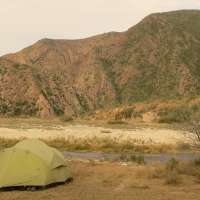 We drive over the narrow path passed low green bushes down the hill until we arrive at a campground. We initially start looking for the reception, but soon find that there is none here. It is a very basic campsite with just a ‘long drop’ (a hole in the ground) as a toilet, no other facilities. There is not even running water.
We drive over the narrow path passed low green bushes down the hill until we arrive at a campground. We initially start looking for the reception, but soon find that there is none here. It is a very basic campsite with just a ‘long drop’ (a hole in the ground) as a toilet, no other facilities. There is not even running water.
And the lack of running water, makes us look at each other for an instant. This morning we did not only leave without extra fuel, we also forgot to buying extra water. We did not even fill up our drinking bags this morning and had already emptied them a while ago. We have taken enough food with us, but if we have no water to cook the rice that is not much use either. It is now too late to drive to another place in the hope that we can get water there. We have no other option that to take water from the river and purify it to use that to eat and drink, just like true adventurers.
This time I start pitching the tent while Peter fills our sink with water from the river. With our filter he filters the dirty water and fills our water bottles until we have enough to cook, drink and even brush our teeth.  We have used the water filter many times before, but really only to purify non-drinkable water from the tap. We have not used it for much dirtier water from the river before. This feels even a bit more adventurous. With a full stomach and a warm cup of tea we enjoy the beautiful starry sky from our seats.
We have used the water filter many times before, but really only to purify non-drinkable water from the tap. We have not used it for much dirtier water from the river before. This feels even a bit more adventurous. With a full stomach and a warm cup of tea we enjoy the beautiful starry sky from our seats.
With drinking water in our camelbaks, we leave for a second day in the Baviaanskloof. Again we only see one car. In this part of the gorge are no villages, shops or farms. It is a beautiful route, even more beautiful than the first day, with a long crossing through the river and amazing views over the hills. At the beginning of the afternoon we hand over our permits at the second checkpoint. We ask the lady at the gate where we can get fuel and just like the first guard she makes a worried face. According to her there is no fuel in the Baviaanskloof.
Outside the closed section of the park, we see some farms again. They are all beautifully old buildings that must have been built here by the first emigrants. As in Pilgrim’s Rest is not difficult to imagine how pioneers crossed through the gorge by wagon, looking for a suitable piece of land.
In the meanwhile we see our fuel gauge getting lower and lower, the tank is almost empty. 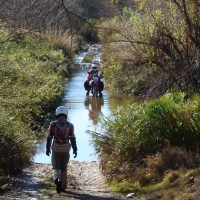 We try in vain to buy fuel at the only two shops in the Baviaanskloof. Everyone refers us to Willowmore, a town more than 90km away. We empty our little 2-liter jerry cans in our tanks and also divide the last bit of fuel from our stove between us. We are lying flat over our tanks, our noses almost touching the handlebars, as we drive as constant as possible towards Willowmore. With clenched buttocks uphill and with a pulled clutch back to use as little fuel as possible going down. The relief is great when we finally arrive in Willowmore at the end of the day. And so it happened that, just when we thought we were already experienced travellers, a nice trip through the park suddenly became a great adventure after all.
We try in vain to buy fuel at the only two shops in the Baviaanskloof. Everyone refers us to Willowmore, a town more than 90km away. We empty our little 2-liter jerry cans in our tanks and also divide the last bit of fuel from our stove between us. We are lying flat over our tanks, our noses almost touching the handlebars, as we drive as constant as possible towards Willowmore. With clenched buttocks uphill and with a pulled clutch back to use as little fuel as possible going down. The relief is great when we finally arrive in Willowmore at the end of the day. And so it happened that, just when we thought we were already experienced travellers, a nice trip through the park suddenly became a great adventure after all.
Distance travelled to Willowmore: 25.225km (15,674 miles)
Click here to view the pictures.
Previous story “The wild South” – Next story “Southern-most tip“





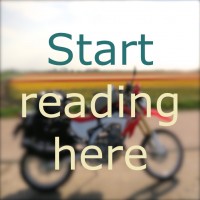


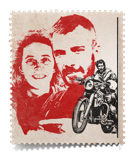
He gelukkig; eind goed al goed!! Liefs
Vanaf het woordje bultrug heb ik het verslag ademloos en met open mond zitten lezen; GA-HA-HAAF! En dan die foto’s….een van mijn favorieten was moe niet stelen nie en die met de doorwaadbare plek, waar jullie allebei op staan?! Geweldig blog.
Dikke kus
Mooi verhaal weer. Ik dacht even dat je met een cliffhanger wilde eindigen, zo van lees de volgende keer hoe dit afloopt
Maar het kwam toch nog goed, gelukkig xxx
Wat een avontuur! Je beschrijft het ook zo spannend met een gelukkig eind. Heel veel plezier verder. Gr. Ben en Anja
The Baviaanskloof is a gem in the Eastern Cape and a great ride on a bike. Did it on a Yamaha XT660 two years ago. keep the stories coming. Have you bought any biltong again?
Regards Deon Lara and kids(Knysna)